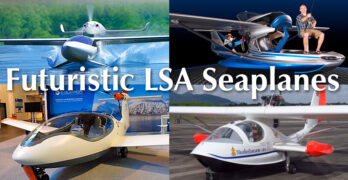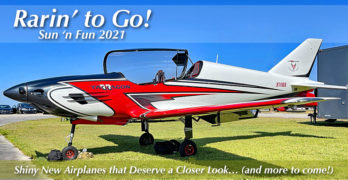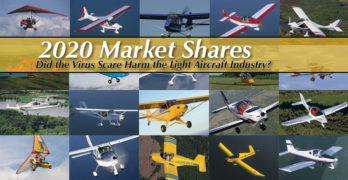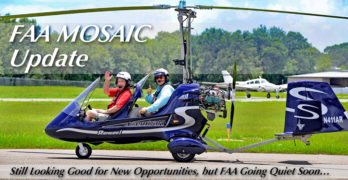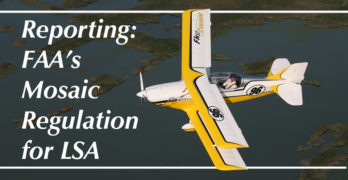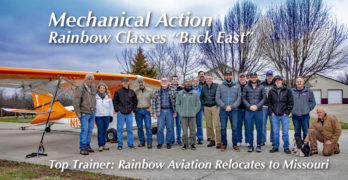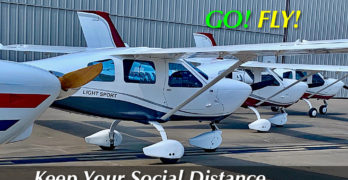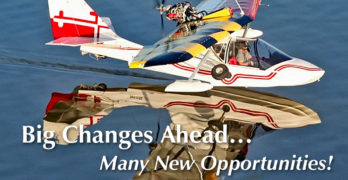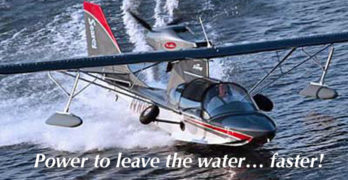UPDATE 11/28/21 — Vickers Aircraft sent fresh images and additional comments. See ••• below. —DJ
Excitement is in the air, even as the season wraps up activity here in the USA. Remember, while winter approaches for Americans, summer is coming to New Zealand.
That might explain an information deficit of late from LSA seaplane developer, Vickers Aircraft. People have been asking questions and reports have become infrequent. Uh, oh…!
Fortunately, the quiet period appears to have a good explanation.
Received November 24th, 2021 — “Hi Dan. Sorry (for a delayed response),” wrote Paul Vickers. “We are pushing very hard for a 10 December first flight. We are structurally testing the wing today.”
Often called a “strongback,” Paul refers to the I-beam steel testing jig seen in the nearby photo. “This was custom designed and manufactured by our Wave team,” he added proudly.
••• “Wave is not just another LSA,” clarified Paul in follow-up email.
Search Results for : searey
Not finding exactly what you expected? Try our advanced search option.
Select a manufacturer to go straight to all our content about that manufacturer.
Select an aircraft model to go straight to all our content about that model.
Wave Theory — After Years of Thoughtful, Thorough Development, First Flight Is Getting Closer
Down under, heads are down and wrenches are wrenching. A team in New Zealand has been working for years on what might be the most sophisticated new aircraft to emerge …well, anywhere among Light-Sport Aircraft but certainly in LSA seaplanes.
Look out, Icon A5! Here comes Wave and it should be quite exciting.
Designer Paul Vickers (see video interview below) has a history in boat-hull design. This history forms a logical path to a LSA seaplane with its boat hull and water control features. Paul employed that experience but has widened his history to encompass a flying boat, the Wave.
From the images that accompany this article, you may see a artist’s sense of style, an engineer’s focus on efficiency, and a creator’s close attention to detail. I think these fresh photos convey those qualities quite well.
Visual Clues
We can pick up a few clues from these “teaser photos.” (Somebody appears to know a thing or two about taking intriguing photos.)
In one image you notice the Rotax 915iS hiding inside its shapely engine nacelle.
Sun ‘n Fun 2021 / Day 0 — Putting On the Shine, Ready for Pilots of All Interests
Pilots heading to Sun ‘n Fun 2021 had no real idea what to expect. As evening approached on Sunday set-up day, a big black storm cloud rolled over Sun ‘n Fun’s Lakeland Airport campus, blowing guard shacks and plastic bathrooms around like pieces of paper. An omen? Hardly! The next morning…
The good news is I saw no damage other than a couple cracked-up guard shacks. No airplane damage was obvious to me. The great news is final setup day was gloriously sunny and exhibit airplanes arrived steadily.
By nightfall on Monday as exhibitors finished their preparations, Sun ‘n Fun was looking good and ready for pilots to descend on the Showgrounds.
Several hands pitched in — thanks loudly to a great group from DeLand Showcase — to turn the LAMA LSA Mall into the regular attraction its become over the last 15 years. A fewer number of airplanes will be shown in the LSA Mall but at least one is a machine you’ve never seen before and others are head turners.
2020 Is History — How Did Light Aircraft Fare in this Year of Fear?
Everyone knows 2020 was arguably the most unusual year in anyone’s recollection. In such a time of global upheaval, how did the light aircraft industry fare?
This report took a bit more time as the effort to begin counting Part 103 ultralights altered our view of the FAA aircraft registration data. Most of you may prefer this simpler report, but the data hounds among readers can drill all the way down to the last aircraft on Tableau Public.
As always, my sincerest thanks goes to our premier datastician Steve Beste. His work is the primary resource for this report. While I deeply appreciated the work done for years by former data guy (and personal friend), Jan Fridrich, Steve’s career in databases gave him skills that few others possess. Since he’s also “one of us” — a trike owner and pilot — Steve understands what we hope to achieve better than data experts outside affordable aviation.
FAA’s New Light-Sport Aircraft Regulation — Progress Update for July 2020
The end is near! Or, is it?
The reference is to the long-running effort to revise the FAA regulation affecting Light-Sport Aircraft. The new ruleset has been discussed back into 2017 and started to take shape in early 2019. Almost two years later, what is the status?
I have reported on this earlier: May 2019 • July 2019 • January 2020 • and April 2020. For additional detail, go back and check those articles. In this newest report — based on LAMA‘s work with the aviation regulator — I will describe the newest development although a short review of the history is useful.
When I ask if the end is near, I mean to ponder if FAA is done with their work. Even some in industry believe FAA is about to release what’s call an NPRM: Notice of Proposed Rule Making.
FAA’s Proposed Regulation (MOSAIC) — LAMA’s Spring 2020 Update Report
In recent months many light aviation enthusiasts have been asking about progress on FAA’s proposed rewrite of the Light-Sport Aircraft regulations. Following a lengthy teleconference in 2019, the Light Aircraft Manufacturers Association is pleased to provide a further update for the agency’s work on MOSAIC, or Modernization of Special Airworthiness Certification. Here is our earlier article on this subject.
This update is one of a continuing series. As time passes and FAA progresses toward its goal — of issuing a NPRM, Notice of Proposed Rule Making — LAMA requests a teleconference or in-person visit to learn the rule writers’ latest concepts and language decisions.
This progress reports identifies new discoveries and clarifies previous statements that may now be better understood.
Some Key Messages
FAA is moving forward on the rulemaking project yet everything remains in progress while the agency gathers internal assessments. What follows is as accurate as possible at this time but changes will occur.
Mechanically-Minded — Rainbow Starts Light-Sport Repairman Training in Missouri
Coronavirus or not, departures from the Golden State of California continue unabated. Before this novel virus “plague” brought isolation around the world, one of our top Light-Sport Aircraft service companies picked up sticks and moved more than halfway across this big country to Kingsville, Missouri (about one hour southeast of Kansas City).
Years ago at the very beginning of Light-Sport Aircraft and Sport Pilot, Rainbow Aviation entrepreneurs Brian and Carol Carpenter started what would become the nation’s largest and most productive repairman training courseware provider.
I recall this husband and wife team coming to EAA headquarters in Oshkosh, Wisconsin. At the time I was consulting to the organization as they prepared for the arrival of the new regulation. Brian and Carol showed up at EAA to brief them on their plans. That was 16 years ago and today Rainbow is the leading supplier of repairman classes.
As the new rule was announced back in 2004, one aspect was the Light Sport Repairmen section, including LSR-Inspection and LSR-Maintenance privileges.
Thinking Positively About A Post-Coronavirus 2020 — Pilots Still Want to Fly
“This, too, shall pass…” said my neighbor, Bill Chernish, who flies for Southwest Airlines. His industry is unusually battered by the coronavirus pandemic. His calm and forward-looking view is refreshing amidst the fear seen, well… everywhere.
For everyone around the globe, the word “coronavirus” or the clumsier “Covid-19” disease it causes, has been the major topic of conversations. Rarely have we seen one theme so dominate all the peoples of the planet. What comes afterward?
I have no crystal ball but two recent posts online gave me a lift. Perhaps you can feel similarly.
Psych’ Up ⬆️
A recent Facebook post showed a pilot flying solo, clearly enjoying himself with a caption something like: “I find many of my favorite hobbies involve social distancing.” I grinned at his use of the new ubiquitous phrase but in the background of his image, the sky looked beautiful and his joy at being aloft was a welcome change of pace from the nonstop bummer news.
Start the Countdown: Four Years Will Bring Huge Changes to Light-Sport Aircraft
As we kick off a new year and a new decade, it feels like the starter’s timer has just been clicked into action. The next four years should prove to be highly interesting — and for all of aviation, not only Light-Sport Aircraft, Sport Pilot kit aircraft, and ultralights. Change can be difficult, but it’s coming. For the most part, I feel this is heading in a great direction even if some may struggle with elements of the new rule.
Earlier, an often-shared report discussed the changes FAA plans as part of a “deregulation” of Light-Sport Aircraft. Below, you can see a video that stimulated numerous comments.
An updated report is still being prepared from a late-fall 2019 discussion with FAA rule writers. That will be sent to LAMA members first with specific details. Other industry pros will get a simpler update so all the makers of our great aircraft can be prepared when the rule is issued no more than four years from now.
The Changing Face of Light-Sport Aircraft — Speed and Safety Behind Single Lever Control
In mid-October, FAA provided another update to the Light Aircraft Manufacturers Association. It speaks to bigger — and faster — flying machines ahead for Light-Sport Aircraft. Let’s look at one aspect of the regulation-in-progress.
First, a caveat: While FAA is communicating some of the ideas they are planning for LSA this is an effort of rule writing likely to see more changes.
What LAMA reports to its members and what we provide here is not certain …although it remains well supported at the top of FAA. Even higher in the federal hierarchy, the Department of Transportation recently gave a go-ahead to continue their work. Not all currently planned ideas may survive either the internal debate nor the public comment period.
Single Lever Control
In-Flight Adjustable Prop
This phrase, Single Lever Control, communicates two things: (1) that the system on the airplane seen in the video adjusts the prop to optimal pitch for the phase of flight, and (2) that the system does so based on the pilot’s movement of the throttle combined with its own information about parameters of the aircraft at that time.
- « Previous Page
- 1
- 2
- 3
- 4
- 5
- 6
- …
- 14
- Next Page »


